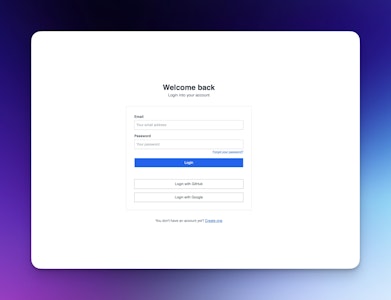How to Add User Authentication to Your SvelteKit MVP in 1 Sprint

Justin Ahinon
Heads up!
At Okupter, our main service is a sprint based Svelte and SvelteKit development aimed at helping startups and small businesses build and ship faster with high-quality web apps and sites .
During our typical 2-week sprints, one of the most common features clients request is adding user authentication.
Implementing a solid authentication system is crucial for many applications, but it can also be a complex task fraught with potential security risks if not done properly . In the world of rapid product development and MVP launches, you don't always have the luxury of months of development time to build out a custom auth solution .
In this post, I want to share some of the knowledge and best practices we've accumulated from implementing user authentication for SvelteKit apps during 1 sprint cycles. My goal is to provide a useful guide for adding basic but production-ready auth to your SvelteKit MVP quickly and securely.
The key considerations I'll cover include:
Rolling your own authentication vs using a third-party provider
Setting up your database schema and ensuring control over user data
Leveraging boilerplate code to accelerate development
Working with an experienced SvelteKit dev shop like Okupter to implement authentication in just 1 sprint
By the end of this post, you should have a better understanding of best practices and options for integrating smooth, secure user authentication into your SvelteKit project on a tight timeline.
Ship That MVP!
Tired of slow development? Get your minimal viable product powered by SvelteKit in just weeks .
Our productized sprints provide the skills and speed to rapidly prototype your app idea.
Just $3.5k per sprint, no long-term contracts .
Roll Your Own Auth vs Use a Third Party
When adding authentication to a SvelteKit app, one of the first decisions is whether to build your own custom authentication logic or use a third-party provider . There are pros and cons to each approach.
Rolling Your Own
Building your own authentication allows for complete customization and control. You can craft the exact user experience and functionality you want, and make sure your authentication system fits properly into your business needs.
On the downside, creating secure, robust authentication logic from scratch is complex . There are many subtle vulnerabilities if you don't know what you're doing.
For fast-moving MVP projects, it often doesn't make sense reinventing the wheel.
Using a Third-Party Provider
Popular third-party authentication providers like Lucia, Auth0, Okta, and Firebase Authentication handle much of the complexity for you out of the box.
Benefits include:
Built-in protection against common vulnerabilities like brute force attacks.
Support for many authentication methods - email/password, social logins, multifactor authentication, etc.
Scalability to handle large user bases.
Time savings from not building and maintaining your own auth system.
Keeping your user credentials and data on a separate system from your app database. This is excellent security hygiene.
The main downsides for some of these solutions are less control and customization ability.
Also, if you choose to go with a closed source / SaaS solution, it's important to look into how your users' data are managed . Do you have full control on how (and where) to store your users' data? Can you access them without overhead or migrate to another solution later on? What if the service goes down, do you have alternative methods to access your data.
These are important questions that could seem trivial at the beginning, but are important to look into.
For MVPs and quick projects, in my experience a third-party solution is often the best route.
Look for providers that allow you to control the user data, like Lucia (this has been our go-to authentication solution for quite some time now) or SvelteKit Auth . To move even faster, you can explore managed database providers that offer built-in authentication features, like Firebase.
With good integration documentation, adding basic third-party sign-in can take as little as 3–4 days in a SvelteKit app.
Spend some time on your database schema
Putting in the effort to design a secure, efficient database schema for your user data is time well spent when implementing authentication. This will pay dividends down the road.
Here are some best practices to follow:
Use role-based access control and permission scopes to restrict data. Segment users into roles like admin, manager, customer. API endpoints and logic should verify the user's role and only return data they are authorized to access.
Encrypt sensitive fields like passwords using
bcryptto hash them. Never store raw passwords. Use salting and multiple rounds of encryption for brute force protection. (Bonus point: if you're using Lucia for authentication, passwords are automatically encrypted and decrypted for you).Structure user tables to only return necessary data. For example, API calls should not include full billing details or other personal info. Expose just enough data for the UI functionality needed.
Index fields like email addresses, usernames and unique IDs to optimize lookup queries. This avoids slow scans for user authentication and common queries.
Anonymize any analytics data collected by encoding usernames, emails or IDs. Retain relationships between events without exposing identities.
Leverage object relational mapping (ORM) libraries like Prisma and Drizzle ORM to implement data access best practices (models integrity, type safe data access) while speeding development.
Enforce account security policies like password complexity rules, login attempt throttling, email verification, etc.
Use back-end form validation for things like sign-up data. Never trust invalidated client-side data.
The time spent on designing clear database tables and access policies pays off in less debugging and refactoring later. It also reduces the risk of critical data exposure security incidents.
Even quick MVP projects warrant thoughtful user data structuring. Performing user research can inform the minimal set of data needed and how to expand the schema later.
Leverage boilerplate code to accelerate development
Boilerplate code is a great way to speed up development and avoid reinventing the wheel. You get to take advantage of the experience and best practices of other developers. This can potentially give you a big head start on your MVP.
At Okupter, we maintain a popular SvelteKit and TypeScript boilerplate called KitForStartups. It includes the following features:
Multiple database support (PostgreSQL, MySQL, SQLite)
Authentication with Lucia
Email/password sign-up and login + email verification
OAuth with Google and GitHub
Email sending with Resend (and a local setup with MailHog)
and more...
Integrating KitForStartups into your new or existing SvelteKit project can potentially shave days off implementing robust authentication logic yourself.
The boilerplate is open source on GitHub, with documentation on customizing it for your use case. While not a pure drop-in solution, KitForStartups demonstrates how to tie together many best practices for authentication in a production-ready manner.
Work with Okupter
Here at Okupter, delivering robust authentication solutions on tight timelines is one of our specialties .
If your goal is to launch your SvelteKit MVP with solid user authentication within a 1 sprint timeframe, partnering with us can help you achieve that.
Our development sprints are structured around focused 2-week cycles. In that compact period, we can build out and polish a production-ready auth system tailored specifically for your app's needs.
Having implemented a handful number of SvelteKit authentication systems for clients, we bring extensive experience accelerating the process without sacrificing quality, security or customization.
During our initial discovery phase, we work closely with you to fully understand your app's user roles, data requirements, flows, edge cases, and UX priorities.
We then architect a solution combining the optimal tools and techniques to match your goals, leveraging platforms like Firebase, Supabase and open source authentication libraries like Lucia.
Throughout the sprint, you get access to our founding engineer, Justin , for collaboration, feedback, and ensuring we're delivering precisely the authentication functionality your app requires.
We handle all the complexity of hashing passwords, implementing protected routes and permissions, securing your API, and providing a smooth interface for registering, logging in, and managing user accounts.
The result is you are able to focus your energies on your app's core differentiators, not authentication plumbing . We translate our expertise into rapid, tangible progress on your roadmap.
If delivering a locked-down MVP with airtight user authentication in just 1 sprint sounds compelling, get in touch!
We're ready to partner with you and transform your SvelteKit app's auth from concept to reality.
Ship That MVP!
Tired of slow development? Get your minimal viable product powered by SvelteKit in just weeks .
Our productized sprints provide the skills and speed to rapidly prototype your app idea.
Just $3.5k per sprint, no long-term contracts .
Wrapping Up
Implementing solid user authentication is crucial for many apps, but also easy to tackle improperly. In this post, we covered proven techniques for integrating smooth, secure auth into your SvelteKit MVP quickly.
Key takeaways include:
Leverage third-party providers or boilerplate to accelerate development
Plan your database schema and data security thoughtfully from the start
Restrict access and anonymize data to mitigate risks
Work with experts like Okupter if aiming to complete authentication in a 1 sprint timeframe
